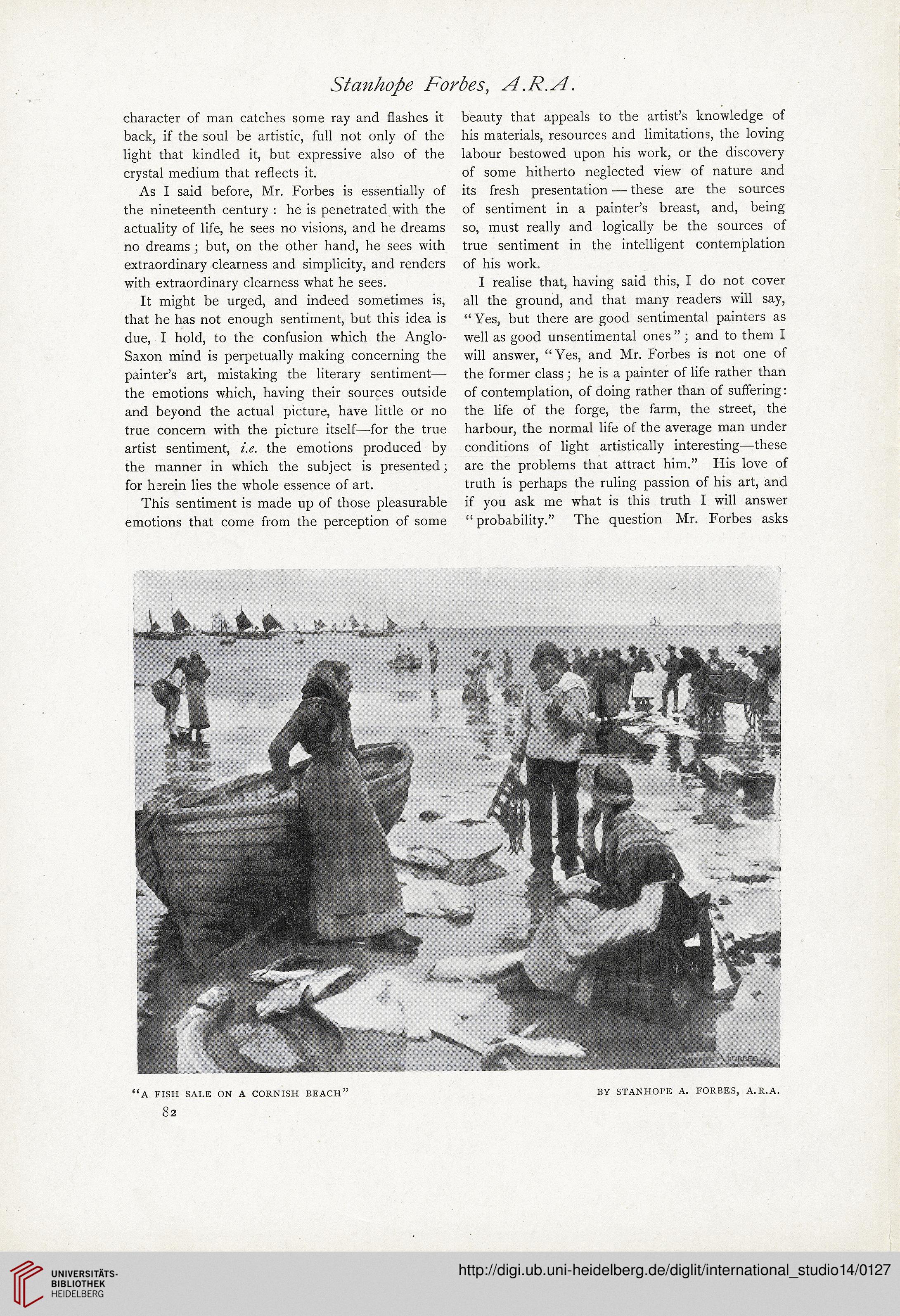Stanhope Forbes, A.R.A.
character of man catches some ray and flashes it
back, if the soul be artistic, full not only of the
light that kindled it, but expressive also of the
crystal medium that reflects it.
As I said before, Mr. Forbes is essentially of
the nineteenth century : he is penetrated with the
actuality of life, he sees no visions, and he dreams
no dreams; but, on the other hand, he sees with
extraordinary clearness and simplicity, and renders
with extraordinary clearness what he sees.
It might be urged, and indeed sometimes is,
that he has not enough sentiment, but this idea is
due, I hold, to the confusion which the Anglo-
Saxon mind is perpetually making concerning the
painter’s art, mistaking the literary sentiment—
the emotions which, having their sources outside
and beyond the actual picture, have little or no
true concern with the picture itself—for the true
artist sentiment, i.e. the emotions produced by
the manner in which the subject is presented;
for herein lies the whole essence of art.
This sentiment is made up of those pleasurable
emotions that come from the perception of some
beauty that appeals to the artist’s knowledge of
his materials, resources and limitations, the loving
labour bestowed upon his work, or the discovery
of some hitherto neglected view of nature and
its fresh presentation — these are the sources
of sentiment in a painter’s breast, and, being
so, must really and logically be the sources of
true sentiment in the intelligent contemplation
of his work.
I realise that, having said this, I do not cover
all the ground, and that many readers will say,
“ Yes, but there are good sentimental painters as
well as good unsentimental ones ” ; and to them I
will answer, “Yes, and Mr. Forbes is not one of
the former class; he is a painter of life rather than
of contemplation, of doing rather than of suffering:
the life of the forge, the farm, the street, the
harbour, the normal life of the average man under
conditions of light artistically interesting—these
are the problems that attract him.” His love of
truth is perhaps the ruling passion of his art, and
if you ask me what is this truth I will answer
“ probability.” The question Mr. Forbes asks
BY STANHOPE A. FORBES, A.R.A.
character of man catches some ray and flashes it
back, if the soul be artistic, full not only of the
light that kindled it, but expressive also of the
crystal medium that reflects it.
As I said before, Mr. Forbes is essentially of
the nineteenth century : he is penetrated with the
actuality of life, he sees no visions, and he dreams
no dreams; but, on the other hand, he sees with
extraordinary clearness and simplicity, and renders
with extraordinary clearness what he sees.
It might be urged, and indeed sometimes is,
that he has not enough sentiment, but this idea is
due, I hold, to the confusion which the Anglo-
Saxon mind is perpetually making concerning the
painter’s art, mistaking the literary sentiment—
the emotions which, having their sources outside
and beyond the actual picture, have little or no
true concern with the picture itself—for the true
artist sentiment, i.e. the emotions produced by
the manner in which the subject is presented;
for herein lies the whole essence of art.
This sentiment is made up of those pleasurable
emotions that come from the perception of some
beauty that appeals to the artist’s knowledge of
his materials, resources and limitations, the loving
labour bestowed upon his work, or the discovery
of some hitherto neglected view of nature and
its fresh presentation — these are the sources
of sentiment in a painter’s breast, and, being
so, must really and logically be the sources of
true sentiment in the intelligent contemplation
of his work.
I realise that, having said this, I do not cover
all the ground, and that many readers will say,
“ Yes, but there are good sentimental painters as
well as good unsentimental ones ” ; and to them I
will answer, “Yes, and Mr. Forbes is not one of
the former class; he is a painter of life rather than
of contemplation, of doing rather than of suffering:
the life of the forge, the farm, the street, the
harbour, the normal life of the average man under
conditions of light artistically interesting—these
are the problems that attract him.” His love of
truth is perhaps the ruling passion of his art, and
if you ask me what is this truth I will answer
“ probability.” The question Mr. Forbes asks
BY STANHOPE A. FORBES, A.R.A.




